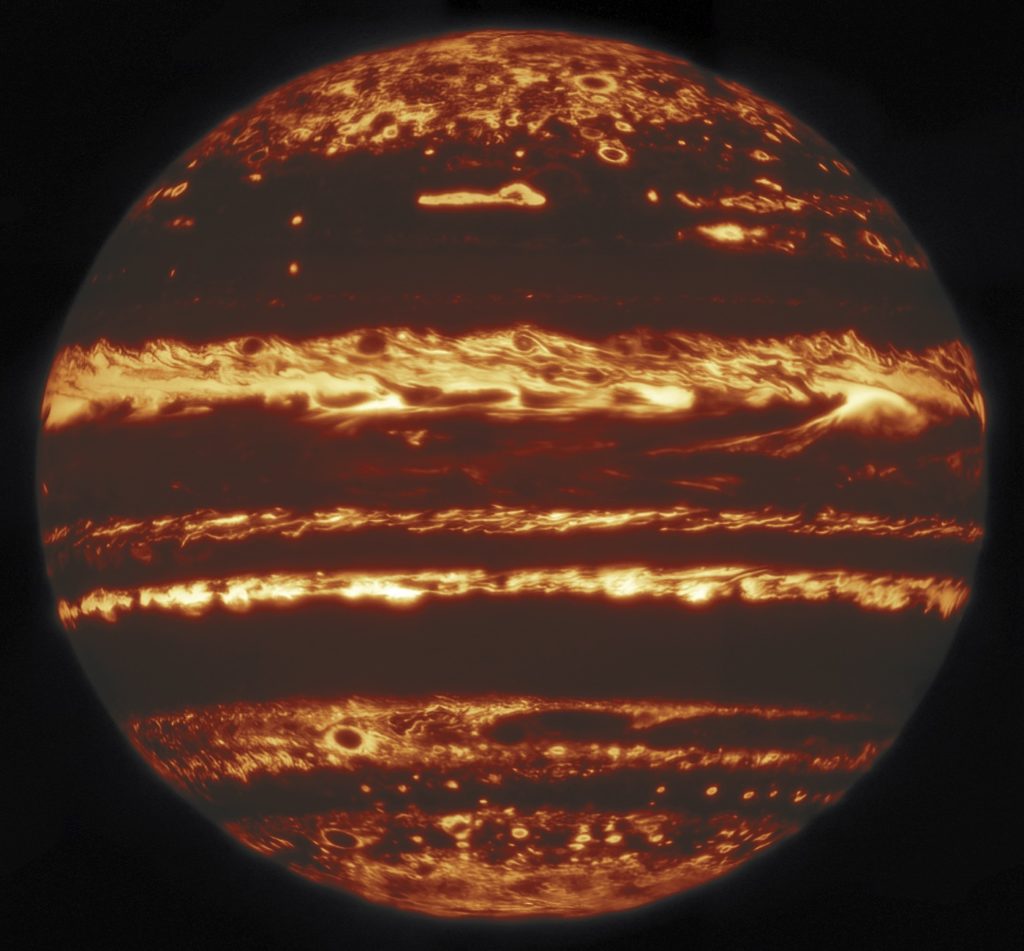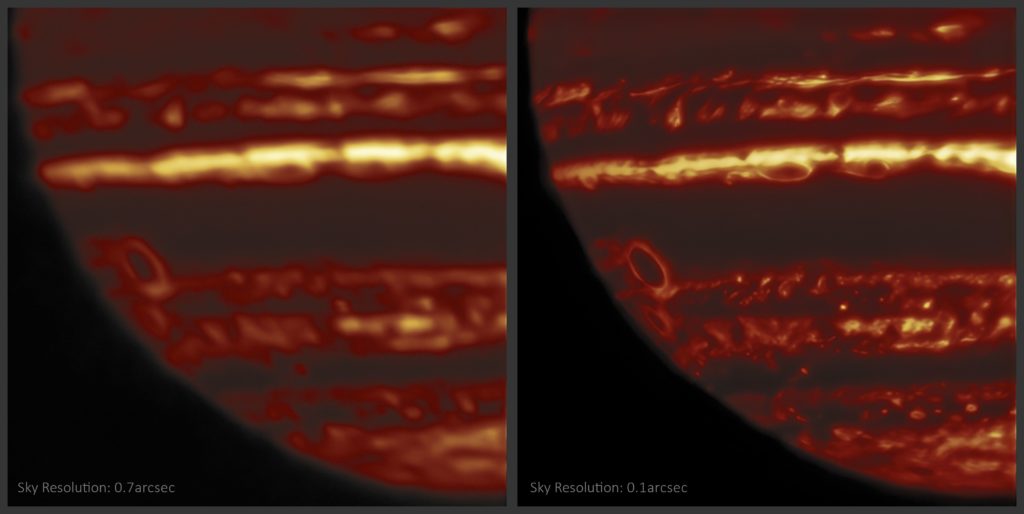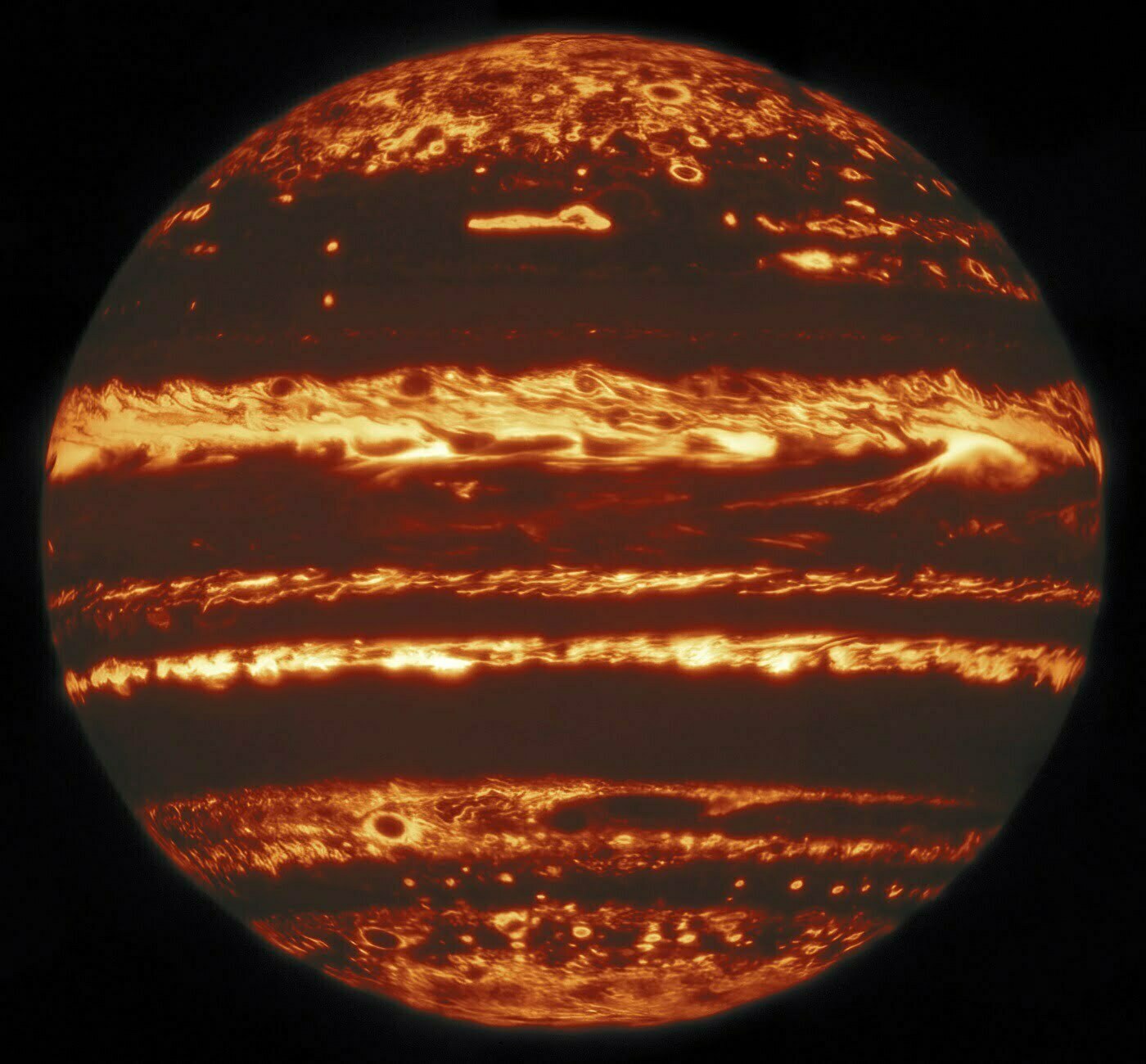Researchers using a technique known as “lucky imaging” with the Gemini North telescope on Hawaii’s Maunakea have collected some of the highest resolution images of Jupiter ever obtained from the ground. These images are part of a multi-year joint observing program with the Hubble Space Telescope in support of NASA’s Juno mission.
The Gemini images, when combined with the Hubble and Juno observations, reveal that lightning strikes, and some of the largest storm systems that create them, are formed in and around large convective cells over deep clouds of water ice and liquid. The new observations also confirm that dark spots in the famous Great Red Spot are actually gaps in the cloud cover and not due to cloud colour variations.
Three years of imaging observations using the international Gemini Observatory, a program of NSF’s NOIRLab, have probed deep into Jupiter’s cloud tops. The ultra-sharp Gemini infrared images complement optical and ultraviolet observations by Hubble and radio observations by the Juno spacecraft to reveal new secrets about the giant planet.
“The Gemini data were critical because they allowed us to probe deeply into Jupiter’s clouds on a regular schedule,” said Michael Wong of UC Berkeley, who led the research team. “We used a very powerful technique called lucky imaging,” adds Wong. With lucky imaging, a large number of very short exposure images are obtained and only the sharpest images, when the Earth’s atmosphere is briefly stable, are used. The result in this case is some of the sharpest infrared images of Jupiter ever obtained from the ground. According to Wong, “These images rival the view from space.”
North’s Near Infrared Imager (NIRI) allows astronomers to peer deep into Jupiter’s mighty storms since the longer-wavelength infrared light can pass through the thin haze but is obscured by thicker clouds high in Jupiter’s atmosphere. This creates a “jack-o-lantern”-like effect in the images where the warm, deep layers of Jupiter’s atmosphere glow through gaps in the planet’s thick cloud cover.
The detailed, multiwavelength imaging of Jupiter by Gemini and Hubble has, over the past three years, proven crucial to contextualizing the observations by the Juno orbiter, and to understanding Jupiter’s wind patterns, atmospheric waves, and cyclones. The two telescopes, together with Juno, can observe Jupiter’s atmosphere as a system of winds, gases, heat, and weather phenomena, providing coverage and insight much like the network of weather satellites meteorologists use to observe Earth.
MAPPING GIANT LIGHTNING STORMS
On each of its close passes over Jupiter’s clouds, Juno detected radio signals created by powerful lightning flashes called sferics (short for atmospherics) and whistlers (so-called because of the whistle-like tone they cause on radio receivers). Whenever possible, Gemini and Hubble focused on Jupiter and obtained high-resolution, wide-area maps of the giant planet to augment the Juno observations.
Juno’s instruments could determine the latitude and longitude coordinates of clusters of sferic and whistler signals. With Gemini and Hubble images at multiple wavelengths, researchers now can probe the cloud structure at these locations. By combining these three pieces of information the research team found that the lightning strikes, and some of the largest storm systems that create them, are formed in and around large convective cells over deep clouds of water ice and liquid.
“Scientists track lightning because it is a marker of convection, the turbulent mixing process that transports Jupiter’s internal heat up to the visible cloud tops,” explained Wong. The largest concentration of lightning seen by Juno came from a swirling storm called a “filamentary cyclone.” Imaging from Gemini and Hubble shows details in the cyclone, revealing it to be a twisted collection of tall convective clouds with deep gaps offering glimpses to the water clouds far below.
“Ongoing studies of lightning sources will help us understand how convection on Jupiter is different from or similar to convection in the Earth’s atmosphere,” Wong commented.
GLOWING FEATURES IN THE GREAT RED SPOT
While scanning the gas giant for gaps in cloud cover, Gemini spotted a telltale glow in the Great Red Spot, indicating a clear view down to deep, warmer atmospheric layers.
“Similar features have been seen in the Great Red Spot before,” said team member Glenn Orton of JPL, “but visible-light observation couldn’t distinguish between darker cloud material, and thinner cloud cover over Jupiter’s warm interior, so their nature remained a mystery.”
Now with the data from Gemini, this mystery is solved. Where visible-light images from Hubble show a dark semicircle in the Great Red Spot, images taken by Gemini using infrared light reveals a bright arc lighting up the region. This infrared glow, from Jupiter’s internal heat, would have been blocked by thicker clouds but can pass through Jupiter’s hazy atmosphere unobscured. By seeing these features as bright infrared hotspots, Gemini confirms that they are gaps in the clouds.
“NIRI at Gemini North is the most effective way for the US and the international Gemini partnership investigators to get detailed maps of Jupiter at this wavelength,” explained Wong. Gemini achieved a 500-kilometre (300-mile) resolution on Jupiter. “At this resolution, the telescope could resolve the two headlights of a car in Miami, seen from New York City,” said Andrew Stephens, the Gemini astronomer who led the observations.{This corresponds to an angular resolution of the Gemini infrared “lucky imaging” observations down to 0.13 arc-seconds.}
“These coordinated observations prove once again that ground-breaking astronomy is made possible by combining the capabilities of the Gemini telescopes with complimentary ground- and space-based facilities,” said Martin Still, an astronomy program director at the National Science Foundation, which is Gemini’s US funding agency. “The international Gemini Partnership provides open access to a powerful combination of large telescopes’ collecting area, flexible scheduling, and a broad selection of interchangeable instruments.”



